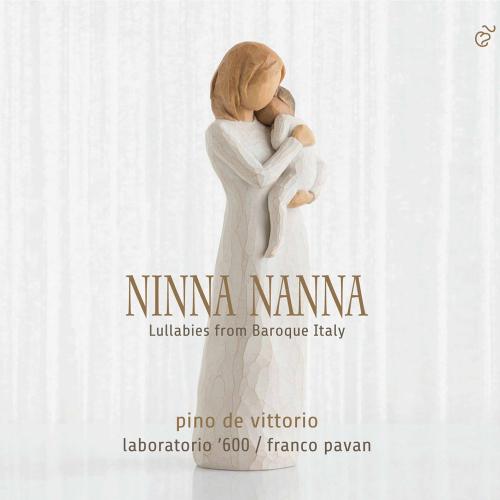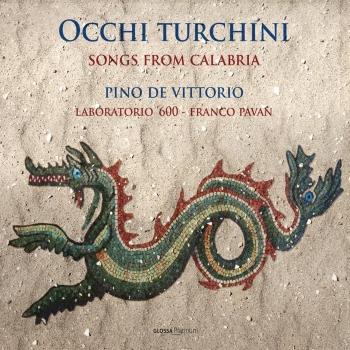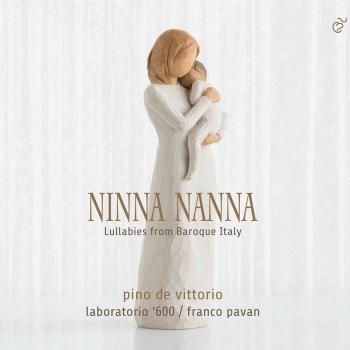
Ninna nanna: Lullabies from Baroque Italy Pino de Vittorio, Laboratorio '600 & Franco Pavan
Album info
Album-Release:
2020
HRA-Release:
17.01.2020
Album including Album cover Booklet (PDF)
- 1 Dormi dormi ben mio 05:15
- 2 Oi nenna nenna 04:48
- 3 Oh, oh, oh, o picciriddu dormi rivo 04:02
- 4 Trotta trotta cavallo memè 01:40
- 5 Pastorale calabrese 01:34
- 6 La bonasera 04:55
- 7 Ninna di Borgia 02:37
- 8 Ninna di Radicena 00:44
- 9 Pastorale (1) 03:20
- 10 Lucciola lucciola vien a me 04:01
- 11 Lucciola lucciola vien da me 01:20
- 12 Lanterna mâgica 02:29
- 13 Fa la nana la mi cuncheta 05:01
- 14 Ninna nanna 02:25
- 15 Aria, che i paesani napoletani sonano con la zampogna 00:43
- 16 Venite, ò pastori 06:03
- 17 Piva 01:56
- 18 Nat'è il Bambino Giesù 03:43
- 19 Pastorale (2) 03:57
- 20 Dolce gioia della mamma 05:09
- 21 Dormi Benigne Jesu 02:36
- 22 Tarantella del presepe 02:24
- 23 Dormi dormi io già non voglio 03:54
- 24 Canna Austina 03:46
Info for Ninna nanna: Lullabies from Baroque Italy
With Ninna Nanna the haunting tones, dramatic intensity and richly characterized singing of Pino De Vittorio once again grace a recording project led by Franco Pavan. Call it Wiegenlied, berceuse, nana, ninna nanna – or countless other terms from around the world – the lullaby, with the rocking of the child’s cradle, is possessed of a captivating charm, all neatly captured in this new collection with the lulling of De Vittorio’s hypnotic voice.
A potent attraction of Ninna Nanna is that the pieces – from the Baroque era – mainly originate from the Mezzogiorno, the southern part of Italy – including the Apulian area from which hails Pino De Vittorio. Seeking to sidestep the well-known and frequently-played, Franco Pavan, who plays the theorbo and the Southern Italian chitarra battente as well as directing Laboratorio ’600, has delved into the popular culture of these regions for inspiration, additionally adding instrumental pieces such as the Tarantella del Presepe by Cristofaro Caresana or the traditional Pastorale calabrese.
By way of the lullaby texts selected here, Pavan conjures up an atmosphere populated by fireflies, the powerful Greek mythological gods of Sleep and Death, Hypnos and Thanatos, Federico García Lorca lecturing on lullabies and referring to the acute sadness of the cradle song, as well as the Virgin Mary and sundry saints being corralled into underpinning the doctrines of the Catholic Church.
Pino De Vittorio, voice
Laboratorio ’600:
Elisa La Marca, lute
Flora Papadopoulos, harp
Franco Pavan, theorbo, archlute, chitarra battente & direction
Laboratorio’600
is a plucked instruments ensemble, and was born to study neglected sources of Italian early music. In our projects the archival research is a very important step, but at the same time only the first step. In fact, the respect for the sources is then mixed with the passion for music.
Laboratorio’600 is open to collaborations with artists that agree this point of view. This is the reason why we decide to begin to work with the singer Pino De Vittorio. The new Cd Siciliane, released by the label Glossa, is the first stone of our new home. We worked to this project for more than two years. For this reason, to grow up more and more, Laboratorio’600 is working on two new and very important projects, related to very particular scores of XVII- and XVIII-Century Italian music.
The attention to the sound is the other aspect of our work. This is the reason why we decided to work on this during the recordings with the exceptional skill of Rino Trasi.
Franco Pavan
is an italian lute and theorbo player. Graduated cum laude both in lute and in musicology in Milan, he has been working as a professional player with the most important Italian early music ensembles such as: Concerto Italiano, Accordone, La Cappella della Pietà dei Turchini, La Risonanza, La Venexiana and with the London based Trinity Baroque. He is working with conductors as Rinaldo Alessandrini, Fabio Bonizzoni, Antonio Florio, Enrico Gatti, Alessandro Ciccolini, Claudio Cavina.
He played in the most important concert halls in Europe (e.g.: Konzerthaus, Berlin; Konzerthaus, Wien; Musikverein, Wien; Cité de la Musique, Paris; Auditorio Nacional, Madrid) and in the world (Teatro Colon, Buenos Aires; Toppan Hall, Tokyo) as well as in Uruguay, Chile, Mexico, Colombia, Brazil, China, Egypt, Morocco.
He recorded over 50 CDs (with the labels Glossa, Opus 111, Emi, Virgin, , Cyprès, Alpha, Arcana, Naïve) and he won prizes like Gramophon Award, Diapason d’Or, Premio Vivaldi della Fondazione Cini, Venezia.
He recorded for all the European Radio broadcasts, and for the French, Italian, German, Spanish, Chinese and Japanese TV. His solo recording “Le Mouton Fabuleux” is the winner of the “Premio del Disco Amadeus 2009”.
In 2012 he began a new duo collaboration with the recorder player Dorothee Oberlinger and founded the Ensemble Laboratorio’600, which first Cd, Siciliane – The Songs of an Island, for the label Glossa was released in 2013.
He teaches Lute at the Conservatorio “E. F. Dall’Abaco” in Verona, Italy. In April, 2014 he was granted with the title of Cultore della Materia of History of Music at the University of Padua
As a musicologist he wrote articles about the lute history and early Seventeenth-Century music, with an important paper on new documents about Claudio Monteverdi and Carlo Gesualdo. He worked for the new edition of The New Grove Dictionary of Music and Musicians and for Die Musik in Geschichte und Gegenwart. He’s part of the Editorial Board of the Journal of the Lute Society of America.
Booklet for Ninna nanna: Lullabies from Baroque Italy













